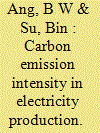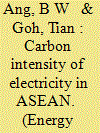| Srl | Item |
| 1 |
ID:
150669


|
|
|
|
|
| Summary/Abstract |
We study changes in the aggregate carbon intensity (ACI) for electricity at the global and country levels. The ACI is defined as the energy-related CO2 emissions in electricity production divided by the electricity produced. It is a performance indicator since a decrease in its value is a desirable outcome from the environmental and climate change viewpoints. From 1990 to 2013, the ACI computed at the global level decreased only marginally. However, fairly substantial decreases were observed in many countries. This apparent anomaly arises from a geographical shift in global electricity production with countries having a high ACI increasingly taking up a larger electricity production share. It is found that globally and in most major electricity producing countries, reduction in their ACI was due mainly to improvements in the thermal efficiency of electricity generation rather than to fuel switching. Estimates of the above-mentioned effects are made using LMDI decomposition analysis. Our study reveals several challenges in reducing global CO2 emissions from the electricity production sector although technically the reduction potential for the sector is known to be great.
|
|
|
|
|
|
|
|
|
|
|
|
|
|
|
|
| 2 |
ID:
149885


|
|
|
|
|
| Summary/Abstract |
The Association of Southeast Asian Nations (ASEAN), with its ten member countries, has a total population exceeding 600 million. Its energy-related CO2 emissions have been growing and in 2013 amounted to 3.6% of total global emissions. About 40% of ASEAN's energy-related CO2 emissions are currently attributable to electricity production. In view of this high share, we study the CO2 emissions of ASEAN's electricity production sector with a focus on the aggregate emission intensity (ACI) given by the level of CO2 emissions for each unit of electricity produced. Drivers of ACI are analysed for individual countries and spatial analysis is conducted by comparing factors contributing to differences between the ACIs of individual countries and that of the ASEAN average. Arising from these analyses and in light of the current developments, it is concluded that drastic actions need to be taken both at the national and regional levels in order to reduce growth in the region's electricity-related CO2 emissions. Two key policy issues, namely overcoming national circumstances to improve electricity generation mix and improving power generation efficiency, are further discussed.
|
|
|
|
|
|
|
|
|
|
|
|
|
|
|
|
| 3 |
ID:
180634


|
|
|
|
|
| Summary/Abstract |
The impact that the Belt and Road Initiative (BRI) has had on carbon emissions is a hotly debated issue. Using a panel dataset of 178 countries from 2002 to 2017, and applying the quantile difference-in-difference method in different industries, this study finds that, first, the BRI overall tends to reduce the carbon emission intensity of BRI countries. Second, the impact of BRI on reducing the carbon emission intensity is significant for BRI countries at higher (0.8 and 0.9) and lower (0.2 and 0.3) carbon emission intensity quantiles but it is insignificant for those at medium levels. Third, the BRI has significant impacts on reducing carbon emission intensity in the energy-intensive industries, and this effect is the highest at the quantile level of 0.9 for all three industries considered here: transportation, electric and heating, and manufacturing and construction. These results indicate that establishing BRI cooperation with China will improve the environment and enhance the sustainable development ability of BRI countries.
|
|
|
|
|
|
|
|
|
|
|
|
|
|
|
|